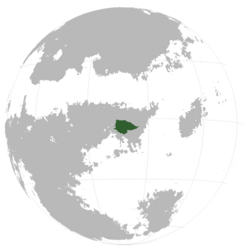Ogtop
| Republic of Ogtop |
||||
|---|---|---|---|---|
|
||||
| Capital | Yezeip | |||
| Largest | Moibaku | |||
| Official languages | Ogtopic, Puhanian | |||
| Ethnic groups | Ogtops 71.3% Aseshans 12.9% Sonkhai 8.6% 3.9 ????? 3.3% Others |
|||
| Government | dominant-party presidential constitutional republic under a totalitarian dictatorship | |||
| - | President | Potu Nebheka | ||
| Formation | ||||
| - | Aseshan North Territory | 1752 | ||
| - | Independence from Asesha | 1959 | ||
| - | Republic | 1961 | ||
| - | Coup d'état | 1999 | ||
| Area | ||||
| - | 573,209.95 km2 221,317.60 sq mi |
|||
| Population | ||||
| - | 2020 census | 53,361,862 | ||
| Gini (2010) | 41.8 medium |
|||
| HDI (2020) | 0.521 low |
|||
| Currency | Mosa (MCA) | |||
| Time zone | SCT+5 | |||
Ogtop (Ogtopic: Ogtops ['ɔɣtops̠]; Puhanian: oxtopo ['oxtopo]), officially the Republic of Ogtop, is a landlocked country located in Puzimm, bordered by Sonka to the north, Asesha to the south, XX to the west and XX to the east. Early civilization in the area included the Proto-Aseshic people tribe in the region....
For most of its years of independence, the country has been plunged into rampant ethnic conflict and its ethnic groups have been embroiled in one of the longest ongoing civil wars in the world.
The country is widely criticized for its poor human rights. Notable issues were its treatment of minorities, press freedoms, and religious freedoms. After its independence from the Aseshan Empire in 1959, the sovereign state of Ogto has been ruled by two repressive totalitarian regimes. It was ruled by President for Life Palhapato Auku (also known as "Cheif of the Ogtops") until his death. Kautu Nauku would be the hereditary president, not just the son of the previous head of state, but following a coup d'état by Potu Nebheka, the latter took power of the nation, officially becoming the new president for life of the country.
Etymology
The name Ogtop come from the Balak word for Mountain hağtap (hağtap) meaning mountain, just because the whole nation lies on the XXXXXX mountains
History
Prehistory
It is possible that the first poeple known that have inhabitated this are were the Aseshic people, but it is likely that more ethnic groups were setteled in this region, such as Proto-MBare which migrated to the south due to the invasions of the Aseshic people from the north.
Antiquity
Research shows tools found in the X Valley dating from 8000 BC appear to offer the first concrete evidence of human settlement in the area. Archaeological evidence suggests an agriculturist society developed during the 4th millennium BC. Burial jars and other kinds of sepulchers, in t suggest a complex society in which bronze objects appeared around 1500 BC.
Dema Kingdom
Dema was a kingdom that existed from the 5th to 10th centuries CE. It is supposed that the site of Dika were the capital of the kingdom because of the presence of numerous temples and ruler's tombs. Although, according to the History of the Great Times, the what was known as "the great city of Dema" was Bine also called as Be-kune. Through this kingdom the Population growth thanks for the exchange with the surrounding kingdoms and for the introducing of the irrigation system and iron tools, including plows. Furthermore, there began to be a militarization controlled by the central power.
After the fall of the Kingdom, the area were dominated by local and bigger foreign kingdom for a small period of time, until the reign of Kumbu who managed to reunite the territory and became a vassal of the reign of Tapela, ensuring protection and military well-being. ...
Aseshan conquest
The Aseshan army began to occupy small strategic territories, in the late 1749, immediately after the border during the Puhania-Ogtop war. The 7th February 1750, Asesha conquered the tribes of XXX, YYY and ZZZ, along the OOO river, what is modern-day Sara region, obtaining more than half of the territories occupied by the Ogtops.
In 1752, the lesser tribes managed to unite in a confederation to counter the enemy. In fact, they did it adequately, gaining some territory back.
The Aseshan empire managed to fortify itself in the conquered territories. It built military bases and river towns mainly to trade and restore the economy and take up the slave trade that the Ogtop tribes were famous for. The war then paused, so that the empire was able to re-establish itself.
The confederation had numerous commercial exchanges, mainly of a belligerent type with Nevira and Balak. This infuriated the Aseshans even more, carrying out massacres and genocides in many cities, as he knew very well that they could not attack the two neighboring empires for reasons of numerical superiority and military capacity.
This did not stop the confederacy by attacking and co-conquering the city of Sala in 1754.
However, in 1755, the last significant resistance in Ogtop territory was crushed at the Battle of Tiig, and shortly thereafter Ogtop was annexed all together.
Geography
Geology
Climate
Biodiversity
Politics
Government
Administrative divisions
Foreign relations
Military
Economy
Transport
Energy
Science and technology
Tourism
Demographics
Ethnic groups
The nation's largest ethnic group are the Ogtops, an Aseshan people, who comprise 72.1% of the population. Other ethnic groups include Aseshan (Puhic) (5.0%) concentrated in the south and Sonkhai (12.6%) living in the north. Small but noticeable minorities include MBare people (1.1%), XXXX (0.9%), and other smaller ethnic minorities.

